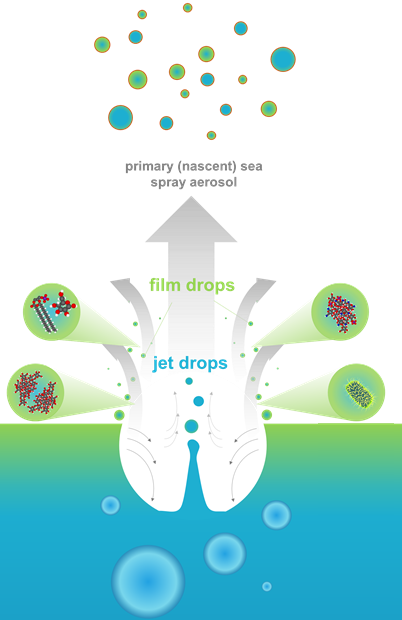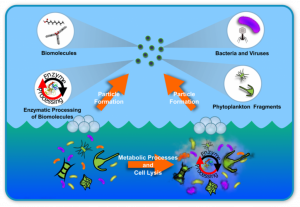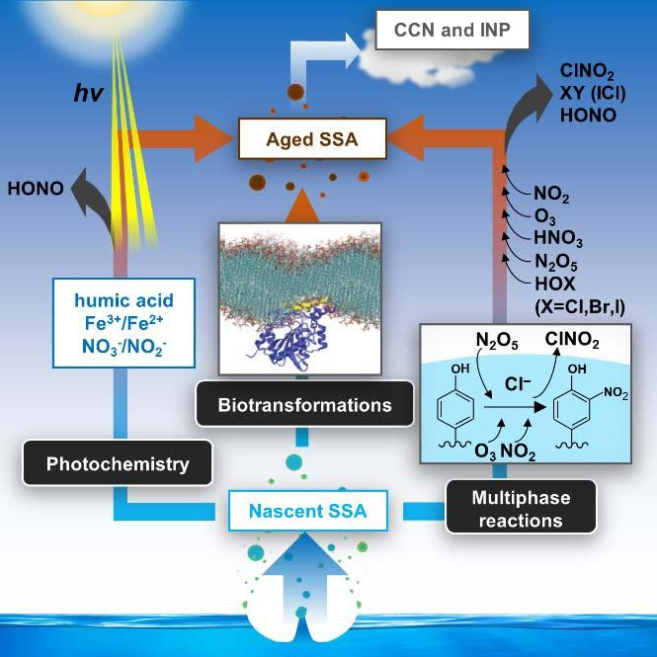Our Science
CAICE investigators perform cutting edge research on complex aerosol chemistry.
Research Themes
Understanding aerosol chemistry-climate interactions is an extraordinary challenge, that can only be effectively addressed by highly collaborative investigations. CAICE research is organized into three broad themes: aerosol-production & composition, aerosol chemical reactions, and aerosol-climate interactions. Under each umbrella, CAICE projects unite the expertise of experimental and computational chemists, marine biologists, oceanographers, and computer scientists.
Aerosol Production & Chemical Complexity
Sea spray aerosols (SSA) are generated from from bubbles bursting at the ocean’s surface. CAICE researchers work to determine the composition, morphology, and internal chemical organization of these sea spray aerosol particles. As illustrated in many CAICE publications these properties of SSA exhibit incredible variability as a function of particle size and the underlying chemistry and biochemistry of the seawater. To build upon this research, CAICE is actively investigating how SSA morphology and physicochemical properties are influenced by underlying fundamental physical, chemical, and biological processes of the bubble bursting mechanism, the air-sea interface, and the bulk seawater. The success of this work depends upon integrating “top-down” studies of complex and realistic aerosol particles with “bottom-up” research, testing fundamental chemical principles by using simple model systems.
Projects
Chemical Reactions at Complex Surfaces
Marine aerosols transform atmospheric gases and are themselves transformed by biological, chemical, and photochemical reactions. In Research Theme 2, we are interested in molecular-level studies to identify the products and unravel the mechanisms of these reaction pathways from first principles. Our overarching goal is to make predictions of chemical processes across a diverse range of solutions involving water, ions, organic molecules, and biological species and study their impact on water uptake, light scattering, and the ice nucleating capabilities of SSA. In parallel, reactions on or within aqueous aerosol particles alter radical and oxidant concentrations in the atmosphere, particularly by accelerating reactions that are inefficient in the gas-phase.
Aerosol-Climate Interactions
CAICE is investigating the impact that individual particle chemistry has on climate properties – namely the ability to affect radiative transfer and clouds via taking up water, serving as liquid cloud seeds (CCN: cloud condensation nuclei), and the ability to form ice crystals (INPs: ice nucleating particles).
It has been hypothesized that the climate-relevant properties of sea spray aerosol, including water uptake and ice nucleating ability, depend on the chemical composition of each particle and phase state. The coverage and ordering of organic molecules on a particle surface is also hypothesized to be a significant factor in affecting climate properties. The chemical complexity of the atmosphere provides an additional and important dimension to aerosol studies, leading to a variety of molecular transformations in particles. Therefore, a range of surface tensions, water solubilities and ice nucleation activities are anticipated for sea spray aerosol particles in the natural environment. CAICE provides the tools and expertise to effectively produce aerosol complexity, and probe the chemical interactions and pathways through experiments and computational simulations.














